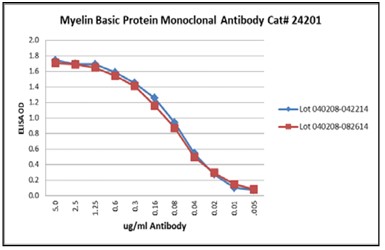Anti-Myelin Basic Protein [MBP101]
Anti-Myelin Basic Protein [MBP101]
Product No.: 24201
- -
- -
Clone MBP101 Target Myelin Basic Protein Formats AvailableView All Product Type Monoclonal Alternate Names MBP, Myelin A1 protein, Myelin membrane encephalitogenic protein Isotype Mouse IgG2b Applications ELISA , IHC , WB |
Data
- -
- -
Antibody DetailsProduct DetailsReactive Species Goat ⋅ Human ⋅ Mouse ⋅ Primate ⋅ Rabbit ⋅ Rat ⋅ Sheep Host Species Mouse Immunogen Purified human myelin basic protein. Product Concentration Lot Specific Formulation PBS, pH 7.4. State of Matter Liquid Product Preparation Purified by Protein G affinity chromatography Storage and Handling This antibody is stable for at least one (1) year at -20°C to -70°C. Store product in appropriate aliquots to avoid multiple freeze-thaw cycles. Country of Origin USA Shipping Next Day 2-8°C Applications and Recommended Usage? Quality Tested by Leinco This antibody may be used in ELISA, immunohistochemistry, and Western blot procedures for detection and/or quantitation of myelin basic protein.ELISA: Human myelin basic protein coated on ELISA wells at 5ug/ml; binding detected with HRP-conjugated goat anti-mouse IgG + ABTS substrate. Each investigator should determine their own optimal working dilution for specific applications. See directions on lot specific datasheets, as information may periodically change. DescriptionSpecificity This antibody reacts with residues 130-136 in human myelin basic protein (21.5kDa and 18.5kDa
molecular forms). It also recognizes primate, rabbit, sheep, goat, rat, and mouse myelin basic
protein. Function The classic group of MBP isoforms (isoform 4-isoform 14) are with PLP the most abundant protein components of the myelin membrane in the CNS. They have a role in both its formation and stabilization. The smaller isoforms might have an important role in remyelination of denuded axons in multiple sclerosis. The non-classic group of MBP isoforms (isoform 1-isoform 3/Golli-MBPs) may preferentially have a role in the early developing brain long before myelination, maybe as components of transcriptional complexes, and may also be involved in signaling pathways in T-cells and neural cells. Differential splicing events combined with optional post-translational modifications give a wide spectrum of isomers, with each of them potentially having a specialized function. Induces T-cell proliferation. {PubMed:8544862}. NCBI Gene Bank ID UniProt.org Research Area Neuroscience References & CitationsTechnical ProtocolsCertificate of Analysis |



